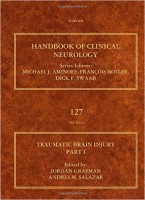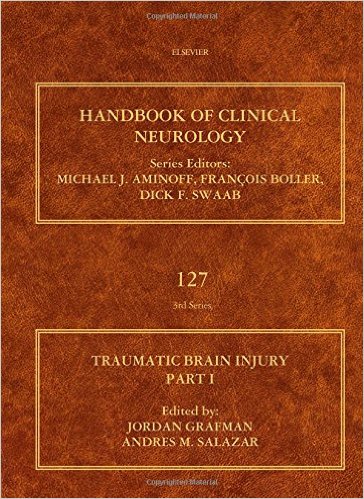 A Volume in the Handbook of Clinical Neurology 3rd Series
A Volume in the Handbook of Clinical Neurology 3rd Series
Editors: Jordan Graeman, PhD; and Andres M. Salazar, MD
Series Editors: Michael J. Aminoff, MD, Francois Boller, MD; and Dick F. Swaab, MD
Publisher: Elsevier – 451 pages
Book Review by: Nano Khilnani
Traumatic brain injury (TBI) in moderate and severe forms is a major challenge in public health in the United States, affecting the young and elderly segments of the population disproportionately, write the editors in their Preface. It can oftentimes affect the thinking and behavior of those who are injured in subtle and sometimes unrecognized ways over a period of time.
Moderate TBI which results in less severe deficits, can affect people not immediately but later on in their lives with neurodegenerative disorders. Severe TBI can be prevented with the use of helmets, but it cannot be eliminated, Drs. Graeman and Salazar contend. They studied and treated Vietnam War veterans, some of whom had penetrating brain injury. They share their knowledge and experience in this book.
In recent years there has been a surge of interest in traumatic brain injury due to the increased incidence of post-traumatic stress disorder (PTSD) among soldiers coming back home from fighting in the Middle East.
This book provides the reader with an updated review of emerging approaches to research, clinical management, and rehabilitation of the TBI patient.
Chapters in this volume cover an extensive range of subjects such as:
- Epidemiology and pathological mechanisms of injury
- Neuroprotection
- Functional sequelae
- Prediction of long-term outcomes
- Neuroplasticity with a strong emphasis on current neurobiological approaches
- Describing the consequences and mechanisms of recovery from TBI.
- Contemporary investigations on blast injury and chronic traumatic encephalopathy
Sixty-eight specialists from the United States and four other countries – Chile, Italy, Thailand and the United Kingdom – contributed to the 28 chapters of this book, which are organized into Parts I and II and eight sections, namely:
- Part I
- Risk and Predisposition
- Pathology and Mechanisms of Traumatic Brain Injury
- Special Considerations
- Current and Emerging Diagnostic Tools
- Management and Treatment
- Part II
- Clinical Sequelae and Long-Term Outcome
- Brain Plasticity and Long-Term Risks
- Continuing Ethical Trials in Brain Injury
In this book, internationally-renowned specialists in this field describe cutting-edge research on the neurobiological response to traumatic brain injury, including descriptions of potential biomarkers and indicators of potential targets for treatments to reduce the impact of the injury.
They explore, among other matters, cellular and molecular mechanisms as well as genetic predictors of outcome. Various diagnostic tools such as computed tomography (CT), magnetic resonance imaging (MRI), electroencephalography (EEG) and resting state functional magnetic resonance imaging (fMRI) are described in this book. State-of-the-art traumatic brain injury management and treatment principles are presented for both civilian and military care.
You as a student or practitioner will find that this book provides you voluminous information packed in compact form. The chapters are relatively short, so it is not surprising that there are as many as 28 of them in a book of only about 450 pages. This comes to an average of only 16 pages per chapter. But you will find some of them much shorter in length.
For example, chapter 2, Classification of Traumatic Brain Injury: Past, Present, and Future, is only just a little more than six pages. In it, you will find like in most other chapters, an Introduction, discussions of topics and subtopics, a Conclusion, and References, which typically are long lists of other books and sources of further information.
Visuals are few and mostly black-and-white but contain detailed captions. Brain scans of various types, charts, figures, tables, and other graphics help explain further what you find in the text portions of the chapters.
Editors:
Jordan Grafman, PhD is director of Brain Injury Research at the Rehabilitation Institute of Chicago, and a professor of physical medicine and rehabilitation. Before joining RIC, Dr. Grafman was director of Traumatic Brain Injury Research at Kessler Foundation. His investigation of brain function and behavior contributes to advances in medicine, rehabilitation, and psychology, and informs ethics, law, philosophy, and health policy.
Andres M. Salazar, MD is Chief Executive Officer, Scientific Director and Co-Founder of Oncovir Inc., a pharmaceutical company developing the immunomodulator, Hiltonol® (Poly-ICLC). He is a retired United States army colonel and formerly professor of neurology at USUHS. He was director of the Vietnam Head Injury Study and founder, principal investigator, and first director of the Defense and Veterans Head Injury Program, an ongoing U.S. National Head Injury clinical management and research effort. His research background includes neurotraumatology, neurodegenerative diseases, multiple sclerosis, AIDS, and oncology.
Series Editors:
Dr. Michael J. Aminoff, MD, FRCP is Director of the Parkinson’s Disease and Movement Disorders Clinic at the University of California, San Francisco. He is an internationally recognized neurologist and expert in diagnosing and treating Parkinson’s disease. His work focuses on treating Parkinson’s disease, particularly issues involving movement and cognition, such as memory disturbances, perception and judgment.
Francois Boller, MD, PhD is a board-certified neurologist with the George Washington Medical Faculty Associates in Washington, DC. He was born in Switzerland and educated in Italy where he obtained a medical degree at the University of Pisa. After specializing in neurology at the University of Milan, Dr. Boller spent several years at the Boston Veterans Administration and Boston University Medical School, including a fellowship under the direction of Dr. Norman Geschwind. He obtained a PhD in experimental psychology from Case Western Reserve University in Cleveland, Ohio where he was in charge of neuroscience teaching at its medical school and was nominated Teacher of the Year.
Dick F. Swaab, MD, PhD is former director of the former Netherlands Institute for Brain Research (now Netherlands Institute for Neuroscience) and founder of the Netherlands Brain Bank. He is professor of neurobiology at the Medical Faculty of University of Amsterdam, mentor of 76 PhD students and author of more than 490 scientific papers in SCI journals and 200 chapters in books. He is editor of 18 b







